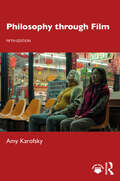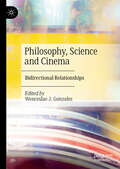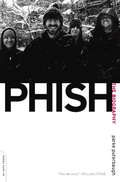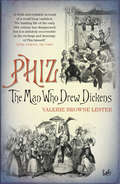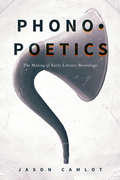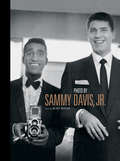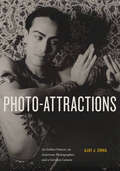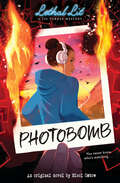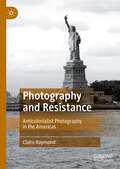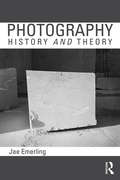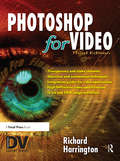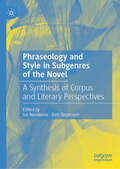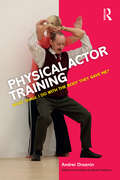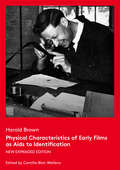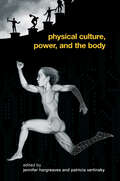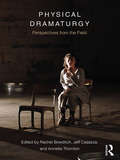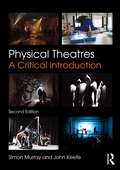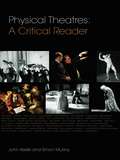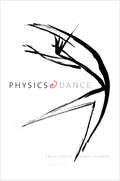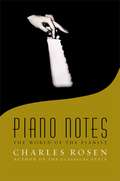- Table View
- List View
Philosophy through Film
by Amy KarofskyThis fifth edition of Philosophy through Film uses recently released, well-received movies to explore answers to classic questions in philosophy in an approachable yet philosophically rigorous manner. Author Amy Karofsky uses two films in each chapter to examine one long-standing philosophical question and assess some of the best solutions to it that have been offered. The chosen movies are not mere “add-ons” to an otherwise straightforward introductory text; instead, they are fully integrated into the discussion of the issues and the various positions. Each chapter also includes discussion questions, an annotated list of films related to the chapter topic, and two or three historically significant primary sources (which are collected together at the end of the book).Changes to the fifth edition include: The replacement of older movies with four new focus films: Anatomy of a Fall, Everything Everywhere All at Once, Get Out, and The Time Traveler’s Wife. The addition of new primary readings from Roderick Chisholm, Jerry Fodor, Baron d’Holbach, and Susan Wolf. Important new sections added to Chapter 1 on Truth (“The Identity Theory of Truth”) and Chapter 5 on Artificial Intelligence (“The I in AI”). A major overhaul of Chapter 6 on free will, determinism, and moral responsibility. Updated notes throughout. The films examined in depth are: Ad Astra; Anatomy of a Fall; Arrival; Beautiful Boy; Crimes and Misdemeanors; Divergent; Equilibrium, Everywhere Everything All at Once; Ex Machina; Get Out; Gone Baby Gone; Her; Inception; Edge of Tomorrow; The Matrix; Memento; A Serious Man; Silence; The Time Traveler’s Wife.For a collection of Story Lines of the Discussed Films by Elapsed Time, visit: www.routledge.com/9781032544595
Philosophy, Science and Cinema: Bidirectional Relationships
by Wenceslao J. GonzalezNow that cinema is offline and online, the capacity of cinema to relate to philosophy and science has increased. In this regard, this book seeks to deepen the relationship between philosophy, science, and cinema in terms of bilaterality. This analysis leads to several successive levels of analysis. First, between philosophy and cinema, where the philosophical perspective bifurcates in several directions, depending on the philosophical branch used. This affects in both directions: from the philosophical orientation to the cinematographic activity and, from cinema, towards the philosophical line used. Second, the relations between science and cinema also go in both directions. Thus, they are modulated by the type of scientific research used and by the film genre employed. Thus, bilaterality is altogether a network of bidirectional relations modulated by various possibilities of analysis.
Phish: The Biography
by Parke PuterbaughDrawing upon nearly fifteen years of exclusive interviews with the members of Phish, veteran music journalist Parke Puterbaugh examines the colorful chemistry that inspired the wildly popular rock group to push their four-man experiment to the limit. An intimate and fascinating portrait,Phish: The Biographyis the definitive story of these Vermont jam-band legends.
Phiz: The Man Who Drew Dickens
by Valerie Lester'Phiz' - Hablot Knight Browne - was the great illustrator of Dickens' fiction. For over twenty-three years they worked together, and Phiz's drawings brought to life a galaxy of much-loved characters, from Mr Pickwick, Nicholas Nickleby and Mr Micawber, to Little Nell and David Copperfield. But, from the mystery of his birth onwards, Phiz himself led a life as rich as any novel. In this vivid, lively memoir - the first full biography, long-awaited by Victorian scholars - his great-great-granddaughter Valerie Browne Lester tracks the struggles of the abandoned Browne family and follows Phiz's path to marriage and fame, his travels around England and Ireland and work with Dickens, Lever, Trollope and others, and his colourful private life. Based on a mass of unpublished material, this enchanting book, packed with surprising and delicious illustrations, is a perfect present for all who love Dickens and enjoy the hidden byways of Victorian life.
Phonopoetics: The Making of Early Literary Recordings
by Jason CamlotPhonopoetics tells the neglected story of early "talking records" and their significance for literature, from the 1877 invention of the phonograph to some of the first recorded performances of modernist works. The book challenges assumptions of much contemporary criticism by taking the recorded, oral performance as its primary object of analysis and by exploring the historically specific convergences between audio recording technologies, media formats, generic forms, and the institutions and practices surrounding the literary. Opening with an argument that the earliest spoken recordings were a mediated extension of Victorian reading and elocutionary culture, Jason Camlot explains the literary significance of these pre-tape era voice artifacts by analyzing early promotional fantasies about the phonograph as a new kind of speaker and detailing initiatives to deploy it as a pedagogical tool to heighten literary experience. Through historically-grounded interpretations of Dickens impersonators to recitations of Tennyson to T.S. Eliot's experimental readings of "The Waste Land" and of a great variety of voices and media in between, this first critical history of the earliest literary sound recordings offers an unusual perspective on the transition from the Victorian to modern periods and sheds new light on our own digitally mediated relationship to the past.
Photo by Sammy Davis, Jr.
by Burt BoyarSammy Davis, Jr. will forever be remembered as one of America's finest entertainers. An all–around performer who could sing, dance, and act, Davis broke racial barriers in the entertainment world and became the only non–white member of the Rat Pack. Only now, however, is Davis's talent as a photographer finally being recognized. In this previously unpublished collection of black and white photography, readers will be fascinated by Davis's portrayals of A–list performers, iconic world leaders, and scenes from everyday life. Davis's subjects include dozens of classic celebrities–such as Frank Sinatra, Marilyn Monroe, Paul Newman, and James Dean–who are often photographed at their most casual and revealing moments.Accompanying the pictures is an assortment of remembrances by Burt Boyar, a longtime friend and traveling companion of Davis who collaborated with the entertainer on both of his autobiographies. Through a series of memorable anecdotes, Boyar reflects on Davis's many achievements as well as the private moments they shared as friends. Along with Davis's candid shots of ordinary life–from a group of children laughing to a baseball game at the Washington Monument–these stories reveal a side of the performer far removed from his Rat Pack persona.The release of this book will also coincide with the release of Burt Boyar's upcoming documentary, Sammy Speaks, created from his extensive archive of taped conversations with the star.
Photo-Attractions: An Indian Dancer, an American Photographer, and a German Camera
by Ajay SinhaIn Spring 1938, an Indian dancer named Ram Gopal and an American writer-photographer named Carl Van Vechten came together for a photoshoot in New York City. Ram Gopal was a pioneer of classical Indian dance and Van Vechten was reputed as a prominent white patron of the African-American movement called the Harlem Renaissance. Photo-Attractions describes the interpersonal desires and expectations of the two men that took shape when the dancer took pose in exotic costumes in front of Van Vechten’s Leica camera. The spectacular images provide a rare and compelling record of an underrepresented history of transcultural exchanges during the interwar years of early-20th century, made briefly visible through photography. Art historian Ajay Sinha uses these hitherto unpublished photographs and archival research to raise provocative and important questions about photographic technology, colonial histories, race, sexuality and transcultural desires. Challenging the assumption that Gopal was merely objectified by Van Vechten’s Orientalist gaze, he explores the ways in which the Indian dancer co-authored the photos. In Sinha’s reading, Van Vechten’s New York studio becomes a promiscuous contact zone between world cultures, where a “photo-erotic” triangle is formed between the American photographer, Indian dancer, and German camera. A groundbreaking study of global modernity, Photo-Attractions brings scholarship on American photography, literature, race and sexual economies into conversation with work on South Asian visual culture, dance, and gender. In these remarkable historical documents, it locates the pleasure taken in cultural difference that still resonates today.
Photobomb (Lethal Lit, Novel #2)
by Micol OstowTig Torres investigates a decades-old cold case -- and a present-day stalker -- in this original novel based on the hit podcast Lethal Lit from Einhorn's Epic Productions and iHeartRadio!Lethal Lit follows Tig Torres, a Cuban-American teen detective in her hometown of Hollow Falls. This second original novel takes place after the events of season two of the hit podcast series, when Tig and her friends investigate the mysterious deaths surrounding a new hotel opening in Hollow Falls.Now, follow Tig as she solves a brand-new mystery with help from her friends Max, Wyn, and Ella.While visiting Hollow Falls’s local art gallery, Tig runs into Darsi, someone she knew back in New York. But an old friend isn't the only unexpected thing Tig finds at the gallery. Tig spots a murder happening in the background of one of the photos in the gallery exhibit. But who was murdered -- and who is the killer?Tig and her friends, including Darsi, are determined to find out what happened to the woman in the photograph. But they don’t realize that they’re being watched. The murder captured in the photo has gone undiscovered for decades -- and someone is willing to kill to keep it that way.Told from Tig’s first-person POV and featuring tons of podcast interstitials, this is a brand-new story not heard on the podcast!
Photography and Resistance: Anticolonialist Photography in the Americas
by Claire RaymondThis book argues that photography, with its inherent connection to the embodied material world and its ease of transmissibility, operates as an implicitly political medium. It makes the case that the right to see is fundamental to the right to be. Limning the paradoxical links between photography as a medium and the conditions of political, social, and epistemological disappearance, the book interprets works by African American, Indigenous American, Latinx, and Asian American photographers as acts of political activism in the contemporary idiom. Placing photographic praxis at the crux of 21st-century crises of political equity and sociality, the book uncovers the discursive visual movements through which photography enacts reappearances, bringing to visibility erased and elided histories in the Americas. Artists discussed in-depth include Shelley Niro, Carrie Mae Weems, Paula Luttringer, LaToya Ruby Frazier, Matika Wilbur, Martine Gutiérrez, Ana Mendieta, An-My Lê, and Rebecca Belmore. The book makes visible the American land as a site of contestation, an as-yet not fully recognized battlefield.
Photography: History And Theory
by Jae EmerlingPhotography: History and Theory introduces students to both the history of photography and critical theory. From its inception in the nineteenth century, photography has instigated a series of theoretical debates. In this new text, Jae Emerling therefore argues that the most insightful way to approach the histories of photography is to address simultaneously the key events of photographic history alongside the theoretical discourse that accompanied them. While the nineteenth century is discussed, the central focus of the text is on modern and contemporary photographic theory. Particular attention is paid to key thinkers, such as Baudelaire, Barthes and Sontag. In addition, the centrality of photography to contemporary art practice is addressed through the theoretical work of Allan Sekula, John Tagg, Rosalind Krauss, and Vilém Flusser. The text also includes readings of many canonical photographers and exhibitions including: Atget, Brassai, August Sander, Walker Evans, The Family of Man, Diane Arbus, Lee Friedlander, Cindy Sherman, Bernd and Hilla Becher, Sebastaio Salgado, Jeff Wall, and others. In addition, Emerling provides close readings of key passages from some major theoretical texts. These glosses come between the chapters and serve as a conceptual line that connects them. Glosses include: Roland Barthes, "The Rhetoric of the Image" (1964) Susan Sontag, Regarding the Pain of Others (2002) Michel Foucault on the archive (1969) Walter Benjamin, "Little History of Photography" (1931) Vilém Flusser, Towards a Philosophy of Photography (1983) A substantial glossary of critical terms and names, as well as an extensive bibliography, make this the ideal book for courses on the history and theory of photography.
Photography: Theoretical Snapshots
by J. J. Long Edward Welch Andrea NobleOver the past twenty-five years, photography has moved to centre-stage in the study of visual culture and has established itself in numerous disciplines. This trend has brought with it a diversification in approaches to the study of the photographic image. Photography: Theoretical Snapshots offers exciting perspectives on photography theory today from some of the world’s leading critics and theorists. It introduces new means of looking at photographs, with topics including: a community-based understanding of Spencer Tunick’s controversial installations the tactile and auditory dimensions of photographic viewing snapshot photography the use of photography in human rights discourse. Photography: Theoretical Snapshots also addresses the question of photography history, revisiting the work of some of the most influential theorists such as Roland Barthes, Walter Benjamin, and the October group, re-evaluating the neglected genre of the carte-de-visite photograph, and addressing photography’s wider role within the ideologies of modernity. The collection opens with an introduction by the editors, analyzing the trajectory of photography studies and theory over the past three decades and the ways in which the discipline has been constituted. Ranging from the most personal to the most dehumanized uses of photography, from the nineteenth century to the present day, from Latin America to Northern Europe, Photography: Theoretical Snapshots will be of value to all those interested in photography, visual culture, and cultural history.
Photoshop for Video
by Richard HarringtonMaster the graphic design and production skills required of today's video editors and motion graphic professionals with this comprehensive guide to the video tools in Adobe Photoshop CS3. Every page is filled with techniques to help the video professional make graphics for use in television, video, the Internet, and DVD. Lively discourse, full-color presentations, and hands-on tutorials demonstrate everything you need to know about how to combine still and moving images. Fundamental concepts such as transparency, pixel aspect ratio, and alpha channels are made precisely clear, and advanced techniques show how to use Photoshop as a character generator, color corrector, and animation tool.This edition features expanded coverage of DVD and motion graphics design, as well as addressing recent developments in High Definition video and 32-bit imaging. This indispensable reference includes:* real-world solutions for making graphics for video* introduction to third party plug-ins* automation and shortcut methods that cut production time* profiles of notable editors and motion graphic artists that include their favorite tips and tricksThe DVD offers a hands-on multimedia experience with hundreds of images to work on, tutorials to complete and 2 ½ hours of video training to watch.
Phraseology and Style in Subgenres of the Novel: A Synthesis of Corpus and Literary Perspectives
by Iva Novakova Dirk SiepmannThis edited book represents the first cohesive attempt to describe the literary genres of late-twentieth-century fiction in terms of lexico-grammatical patterns. Drawing on the PhraseoRom international project on the phraseology of contemporary novels, the contributed chapters combine literary studies with corpus linguistics to analyse fantasy, romance, crime, historical and science fiction in French and English. The authors offer new insights into long-standing debates on genre distinction and the hybridization of genres by deploying a new, interdisciplinary methodology. Sitting at the intersection of literature and linguistics, with a firm grounding in the digital humanities, this book will be of particular relevance to literary scholars, corpus stylists, contrastivists and lexicologists, as well as general readers with an interest in twentieth-century genre fiction.
Physical Actor Training: What Shall I Do with the Body They Gave Me?
by Andrei DrozninIf, as an actor, your body is your 'instrument' - and the only way you can express the internal impulses of the character you’re playing - what happens when the body-mind, ‘psychophysical’ connection is lost? Andrei Droznin, Russia's foremost teacher of physical actor training, calls this loss the 'desomatization' of the human body, and argues that these connections urgently need to be restored for full expressivity. This is a genuinely unique book which links theory to practice by a man who has worked at the very top of Russian theatre; a movement specialist who has taught at the Moscow Art Theatre as well as drama schools all over the world. Beautifully translated by Natasha Fedorova, this volume will excite and inspire a new generation of English-language readers.
Physical Characteristics of Early Films as Aids to Identification: New expanded Edition
by Camille Bolt-WellensAny archivists who have held a piece of fi lm in their hands, wondering how to go about identifying it, recognize the true value of fi lm preservationist Harold Brown's work. In 1967 Brown delivered a pioneering lecture on the identification of early films at the annual Congress of the International Federation of Film Archives (FIAF) in East Berlin. Years of working with Britain's National Film Archive collections, and the close examination of thousands of nitrate prints of the silent period, made Brown a leading authority on early fi lm identification, and an unsurpassed model of methodological consciousness in the archival field. In 1990, FIAF published Brown's Physical Characteristics of Early Films as Aids to Identification, an updated version and a continuation of his 1967 lecture. This publication has long been archivists' trusted companion, constituting a concentrated encyclopedia on all the information that can be discovered or verified through aspects of the fi lm other than the actual projected image – such as perforation shapes; embossed and punched marks; stock manufacturers' and producers' edge marks; frame characteristics; title styles; and production serial numbers. It also included essays on key individual production companies of the silent era. Over the last 30 years, this manual – a basic typewritten 100-page volume (including 20 pages of black & white illustrations), with its easily recognizable red cover – has been an invaluable reference for fi lm archivists and scholars. However, as Brown himself acknowledged in the 1990 edition, the manual was far from definitive. Camille Blot-Wellens, the editor of this new, expanded edition of Brown's 1990 book, belongs to the new generation of researchers who have used Physical Characteristics extensively in their work and have gathered considerable new information on the subject. This new edition is the result of a project she initiated in 2014 with FIAF's support. Brown's original text is now augmented with new original research on key fi lm manufacturers and producers by Camille Bolt-Wellens and other leading archivists and researchers in the field. Richly illustrated (the book contains over 900 images, including 125 in full color), this new 336-page edition of Harold Brown's seminal manual will be welcomed by many, and will no doubt become a must-have working tool for many in the fi lm archiving and academic fields.
Physical Culture, Power, and the Body (Routledge Critical Studies in Sport)
by Patricia Vertinsky Jennifer HargreavesDuring the past decade, there has been an outpouring of books on 'the body' in society, but none has focused as specifically on physical culture - that is, cultural practices such as sport and dance within which the moving physical body is central. Questions are raised about the character of the body, specifically the relation between the ‘natural’ body, the ‘constructed’ body and the ‘alien’ or ‘virtual’ body. The themes of the book are wide in scope, including: physical culture and the fascist body sport and the racialised body sport medicine, health and the culture of risk the female Muslim sporting body, power, and politics experiencing the disabled sporting body embodied exhibitions of striptease and sport the social logic of sparring sport, girls and the neoliberal body. Physical Culture, Power, and the Body aims to break down disciplinary boundaries in its theoretical approaches and its readership. The author’s muli-disciplinary backgrounds, demonstrate the widespread topicality of physical culture and the body.
Physical Dramaturgy: Perspectives from the Field
by Rachel Bowditch Jeff Casazza Annette ThorntonWhat is physical dramaturgy? While the traditional dramaturg shares research intellectually, the physical dramaturg does so viscerally and somatically. By combining elements of text, history, dramatic structure, and the author’s intent with movement analysis and physical theatre pedagogies, the physical dramaturg gives actors the opportunity to manifest their work in a connected and intuitive manner and creates a field that is as varied and rich as the theatre itself. Physical Dramaturgy: Perspectives from the Field explores the ways in which this unique role can benefit the production team during the design and rehearsal phases of both traditional and devised productions. Individual chapters look at new ways of approaching a wealth of physical worlds, from the works of Shakespeare and other period playwrights to the processes of Jerzy Grotowski, Lloyd Williamson, Richard Schechner, and Michael Chekhov, and devising original works in a variety of contexts from Pig Iron, Dell’Arte International, Bill Bowers and mime, Tectonic Theater Project, and Liz Lerman’s Dance Exchange. This anthology gives dramaturgs, actors, and directors new ways of looking at existing methods and provides examples of how to translate, combine, and adapt them into new explorations for training, rehearsal, or research.
Physical Theatres: A Critical Introduction
by Simon Murray John KeefeThis new edition of Physical Theatres: A Critical Introduction continues to provide an unparalleled overview of non-text-based theatre, from experimental dance to traditional mime. It synthesizes the history, theory and practice of physical theatres for students and performers in what is both a core area of study and a dynamic and innovative aspect of theatrical practice. This comprehensive book: traces the roots of physical performance in classical and popular theatrical traditions looks at the Dance Theatre of DV8, Pina Bausch, Liz Aggiss and Jérôme Bel examines the contemporary practice of companies such as Théatre du Soleil, Complicite and Goat Island focuses on principles and practices in actor training, with reference to figures such as Jacques Lecoq, Lev Dodin, Philippe Gaulier, Monika Pagneux, Etienne Decroux, Anne Bogart and Joan Littlewood. Extensive cross references ensure that Physical Theatres: A Critical Introduction can be used as a standalone text or together with its companion volume, Physical Theatres: A Critical Reader, to provide an invaluable introduction to the physical in theatre and performance. New to this edition: a chapter on The Body and Technology, exploring the impact of digital technologies on the portrayal, perception and reading of the theatre body, spanning from onstage technology to virtual realities and motion capture; additional profiles of Jerzy Grotowski, Wrights and Sites, Punchdrunk and Mike Pearson; focus on circus and aerial performance, new training practices, immersive and site-specific theatres, and the latest developments in neuroscience, especially as these impact on the place and role of the spectator.
Physical Theatres: A Critical Reader
by Simon Murray John KeefePhysical Theatres: A Critical Reader is an invaluable resource for students of physically orientated theatre and performance. This book aims to trace the roots and development of physicality in theatre by combining practical experience of the field with a strong historical and theoretical underpinning. In exploring the histories, cross-overs and intersections of physical theatres, this critical Reader provides: six new, specially commissioned essays, covering each of the book’s main themes, from technical traditions to contemporary practises discussion of issues such as the foregrounding of the body, training and performance processes, and the origins of theatre in both play and human cognition a focus on the relationship and tensions between the verbal and the physical in theatre contributions from Augusto Boal, Stephen Berkoff, Étienne Decroux, Bertolt Brecht, David George, J-J. Rousseau, Ana Sanchez Colberg, Michael Chekhov, Jeff Nuttall, Jacques Lecoq, Yoshi Oida, Mike Pearson, and Aristotle.
Physics and Dance
by Emily Coates Sarah DemersA fascinating exploration of our reality through the eyes of a physicist and a dancer—and an engaging introduction to both disciplines From stepping out of our beds each morning to admiring the stars at night, we live in a world of motion, energy, space, and time. How do we understand the phenomena that shape our experience? How do we make sense of our physical realities? Two guides—a former member of New York City Ballet, Emily Coates, and a CERN particle physicist, Sarah Demers—show us how their respective disciplines can help us to understand both the quotidian and the deepest questions about the universe. Requiring no previous knowledge of dance or physics, this introduction covers the fundamentals while revealing how a dialogue between art and science can enrich our appreciation of both. Readers will come away with a broad cultural knowledge of Newtonian to quantum mechanics and classical to contemporary dance. Including problem sets and choreographic exercises to solidify understanding, this book will be of interest to anyone curious about physics or dance.
Pianist's Progress
by Helen Drees RuttencutterIn Pianist's Progress, Helen Ruttencutter takes the reader behind the scenes in the fiercely competitive music world, vividly depicting a young musician's quest for a career. But ultimately her subject is the dynamics of training and grooming for success.
Piano Notes: The World of the Pianist
by Charles RosenCharles Rosen is one of the world's most talented pianists -- and one of music's most astute commentators. Known as a performer of Bach, Beethoven, Stravinsky, and Elliott Carter, he has also written highly acclaimed criticism for sophisticated students and professionals. In Piano Notes, he writes for a broader audience about an old friend -- the piano itself. Drawing upon a lifetime of wisdom and the accumulated lore of many great performers of the past, Rosen shows why the instrument demands such a stark combination of mental and physical prowess. Readers will gather many little-known insights -- from how pianists vary their posture, to how splicings and microphone placements can ruin recordings, to how the history of composition was dominated by the piano for two centuries. Stories of many great musicians abound. Rosen reveals Nadia Boulanger's favorite way to avoid commenting on the performances of her friends ("You know what I think," spoken with utmost earnestness), why Glenn Gould's recordings suffer from "double-strike" touches, and how even Vladimir Horowitz became enamored of splicing multiple performances into a single recording. Rosen's explanation of the piano's physical pleasures, demands, and discontents will delight and instruct anyone who has ever sat at a keyboard, as well as everyone who loves to listen to the instrument. In the end, he strikes a contemplative note. Western music was built around the piano from the classical era until recently, and for a good part of that time the instrument was an essential acquisition for every middle-class household. Music making was part of the fabric of social life. Yet those days have ended. Fewer people learn the instrument today. The rise of recorded music has homogenized performance styles and greatly reduced the frequency of public concerts. Music will undoubtedly survive, but will the supremely physical experience of playing the piano ever be the same?
Piccadilly: The Circus at the Heart of London
by Midge GilliesThere's nowhere quite like Piccadilly Circus.From the moment they emerge, blinking from the underground station, visitors to Piccadilly Circus face a sensory onslaught. Its streets and alleyways merge into an intoxicating thoroughfare, with the power to propel an individual onwards to adventure, romance, or something more sinister. Ever since its iconic Eros statue appeared in 1893, the junction has been a vibrant meeting place, attracting visitors and pleasure-seekers from all walks of life: political plans and theatrical careers were hatched at its restaurant and café tables, lovers met below the statue of Eros, and to this day tourists pour out of its historic Tube to experience the bright lights of London's nightlife.Piccadilly explores how the area has been shaped by social and historical events - from female suffrage to world wars to technological advancements - and by its colourful cast of characters - from flower girls, shop assistants and sex workers, to film stars, Bright Young Things and conmen (and women).For many, the Circus has represented both a home from home and a brave new world, as campaigners, revellers, opportunists and romantics have all been drawn to Piccadilly's bright lights. This is the story of why Piccadilly Circus continues to mean so much to so many.
Piccadilly: The Circus at the Heart of London
by Midge GilliesA people's history of Piccadilly: London's bustling meeting place for over a century.There's nowhere quite like Piccadilly Circus.From the moment they emerge, blinking from the underground station, visitors to Piccadilly Circus face a sensory onslaught. Its streets and alleyways merge into an intoxicating thoroughfare, with the power to propel an individual onwards to adventure, romance, or something more sinister. Ever since its iconic Eros statue appeared in 1893, the junction has been a vibrant meeting place, attracting visitors and pleasure-seekers from all walks of life: political plans and theatrical careers were hatched at its restaurant and café tables, lovers met below the statue of Eros, and to this day tourists pour out of its historic Tube to experience the bright lights of London's nightlife.Piccadilly explores how the area has been shaped by social and historical events - from female suffrage to world wars to technological advancements - and by its colourful cast of characters - from flower girls, shop assistants and sex workers, to film stars, Bright Young Things and conmen (and women).For many, the Circus has represented both a home from home and a brave new world, as campaigners, revellers, opportunists and romantics have all been drawn to Piccadilly's bright lights. This is the story of why Piccadilly Circus continues to mean so much to so many.(P) 2022 Hodder & Stoughton Limited
Pickin' on Peachtree: A History of Country Music in Atlanta, Georgia (Music in American Life)
by Wayne W. DanielAtlanta played a major role in launching the country music industry in the early 1920s and remained one of the nation’s leading country music centers for four decades. Also a major recording center for twenty years, the city was visited regularly by representatives of New York record companies who traveled south to scout for singers and musicians. During the 1950s, Atlanta’s television stations drew on the talent that had entertained in the area for years to assemble long-running, popular country music shows. Using fresh and fascinating information gleaned from newspaper archives, personal interviews, and other sources, Wayne W. Daniel takes readers from early fiddling conventions through the beginnings of the country music industry, to the early days of country programming on radio, and on through Atlanta’s importance as a regional recording center. He includes an analysis of the role television has played from the 1950s to the present. “If there are still people around who think country music moved right out of the hills directly to Nashville, Wayne Daniel’s book should disabuse them of that. Atlanta was country music’s real birthplace, and has remained a vital and energetic center; Pickin ’ on Peachtree presents a wealth of new information and research, and establishes the importance of Atlanta in the rise of one of America’s most unique art forms.” -- Charles Wolfe, author of Tennessee Strings and Kentucky Country “In this thoroughly researched history of country music in Atlanta, Wayne Daniel explores the major artists, promoters, and industry executives who gave Atlanta’s country music its luster. . . . No one interested in country music, whether in fiddle conventions of the 1910s, the ‘golden age’ of recordings of the 1920s, the early radio barn dance broadcasts of the 1930s and ’40s, or country music on television in the ’50s and beyond will fail to find something of interest in Pickin ’ on Peachtree. -- Norm Cohen, author of Long Steel Rail: The Railroad in American Folksong Wayne w. Daniel is the author of more than 75 articles in Bluegrass Unlimited, Journal of Country Music, Devil’s Box, and other publications.
